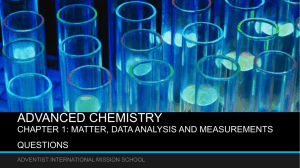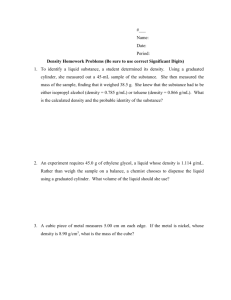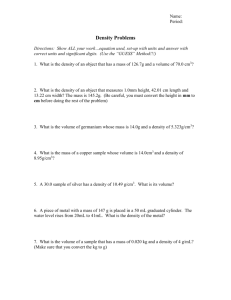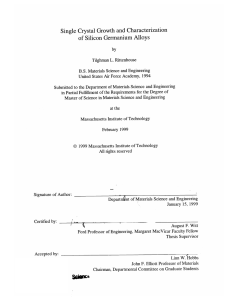HW set 1
advertisement
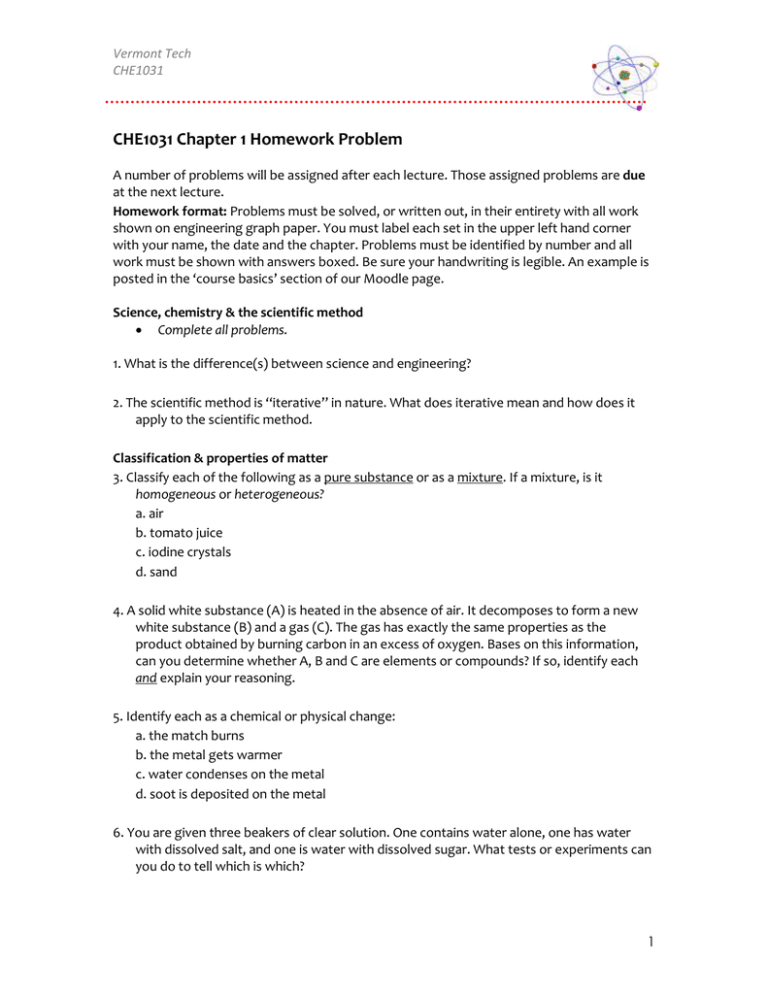
Vermont Tech CHE1031 CHE1031 Chapter 1 Homework Problem A number of problems will be assigned after each lecture. Those assigned problems are due at the next lecture. Homework format: Problems must be solved, or written out, in their entirety with all work shown on engineering graph paper. You must label each set in the upper left hand corner with your name, the date and the chapter. Problems must be identified by number and all work must be shown with answers boxed. Be sure your handwriting is legible. An example is posted in the ‘course basics’ section of our Moodle page. Science, chemistry & the scientific method Complete all problems. 1. What is the difference(s) between science and engineering? 2. The scientific method is “iterative” in nature. What does iterative mean and how does it apply to the scientific method. Classification & properties of matter 3. Classify each of the following as a pure substance or as a mixture. If a mixture, is it homogeneous or heterogeneous? a. air b. tomato juice c. iodine crystals d. sand 4. A solid white substance (A) is heated in the absence of air. It decomposes to form a new white substance (B) and a gas (C). The gas has exactly the same properties as the product obtained by burning carbon in an excess of oxygen. Bases on this information, can you determine whether A, B and C are elements or compounds? If so, identify each and explain your reasoning. 5. Identify each as a chemical or physical change: a. the match burns b. the metal gets warmer c. water condenses on the metal d. soot is deposited on the metal 6. You are given three beakers of clear solution. One contains water alone, one has water with dissolved salt, and one is water with dissolved sugar. What tests or experiments can you do to tell which is which? 1 Vermont Tech CHE1031 Units & measurement Complete all problems. 7. What exponential notation do the following abbreviations represent: a. d b. c c. f d. μ e. M f. k g. n h. m i. p 8. A cube of osmium metal 1.500 cm on each side has a mass of 76.31 g at 25°C. Calculate density in g/cm3 at this temperature? 9. The density of titanium metal is 4.51 g/cm3 at 25°C. What mass of Ti displaces 125.0 mL of water at that temperature? 10. The label fell off a bottle of clear liquid. The lab tech thinks that it’s benzene – a nasty carcinogen – and measures its density to try and confirm this. A 25.0-mL volume of the liquid has a mass of 21.95 g. The density of benzene is 0.8787 g/mL at 15°C. Was the tech right? Uncertainty in measurement: Complete all problems. 11. Which are exact numbers? a. Mass of a 16-oz. bag of coffee from Vermont Coffee Company b. Number of students in class c. The temperature of the surface of the sun d. The mass of a postage stamp e. The number of millimeters in a cubic meter of water f. the average height of students at the college 2 Vermont Tech CHE1031 12. How many significant figures in each of these numbers: a. 3.774 km b. 205 m2 c. 1.700 cm d. 350.00 K e. 307.080 g f. 1.3 x 103 m/s 13. The diameter of the Earth at the equator is 7926.381 miles. Round that to 3 sig figs and express it with scientific notation. 14. Express the answer to each problem with the correct number of significant figures. a. 320.5 – (6104.5/2.3) = b. ((285.3 x 105) – (1.200 x 103)) x 2.8954 = c. (0.0045 x 20,000.0) + (281.3 x 12) = d. 863 x (1255 – (3.45 x 108)) = Dimensional analysis: Complete either 15 – 17 or 18 & 19. 15. Bamboo can grow up to 60.0 cm per day. Convert that to inches per hour. 16. Convert the speed of sound, 344 meters per second, into km per hour. 17. The recommended adult dose of Elixophyllin, an asthma drug, is 6 mg/kg of body weight. What’s the dose (mg) for a 185-lb person? 18. Silicon for computer chips is grown in large cylinder called “boules”. One boule is 300 mm in diameter and 2 m tall. The density of Si is 2.33 g/cm3. Silicon wafers for making integrated circuits are sliced from a 2.0 m boule and are 0.75 mm thick and 300 mm in diameter. a. How many wafers can be cut from a single boule? b. What is the mass of one wafer? 19. The concentration of carbon monoxide in an urban apartment is 48 μg/m3. What is the mass (g) of CO in room that measures 11.0 x 11.5 x 20.5 ft? 3



